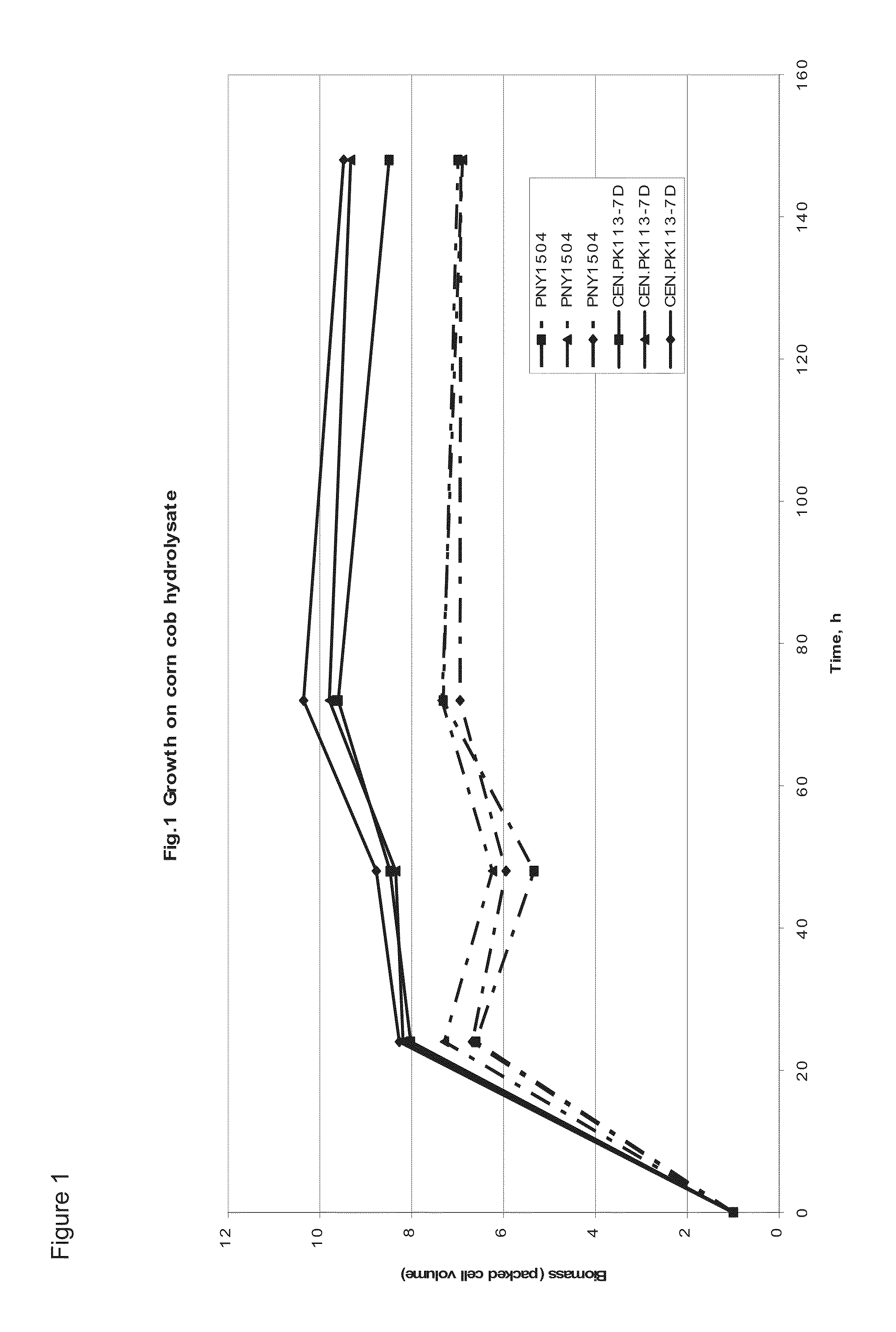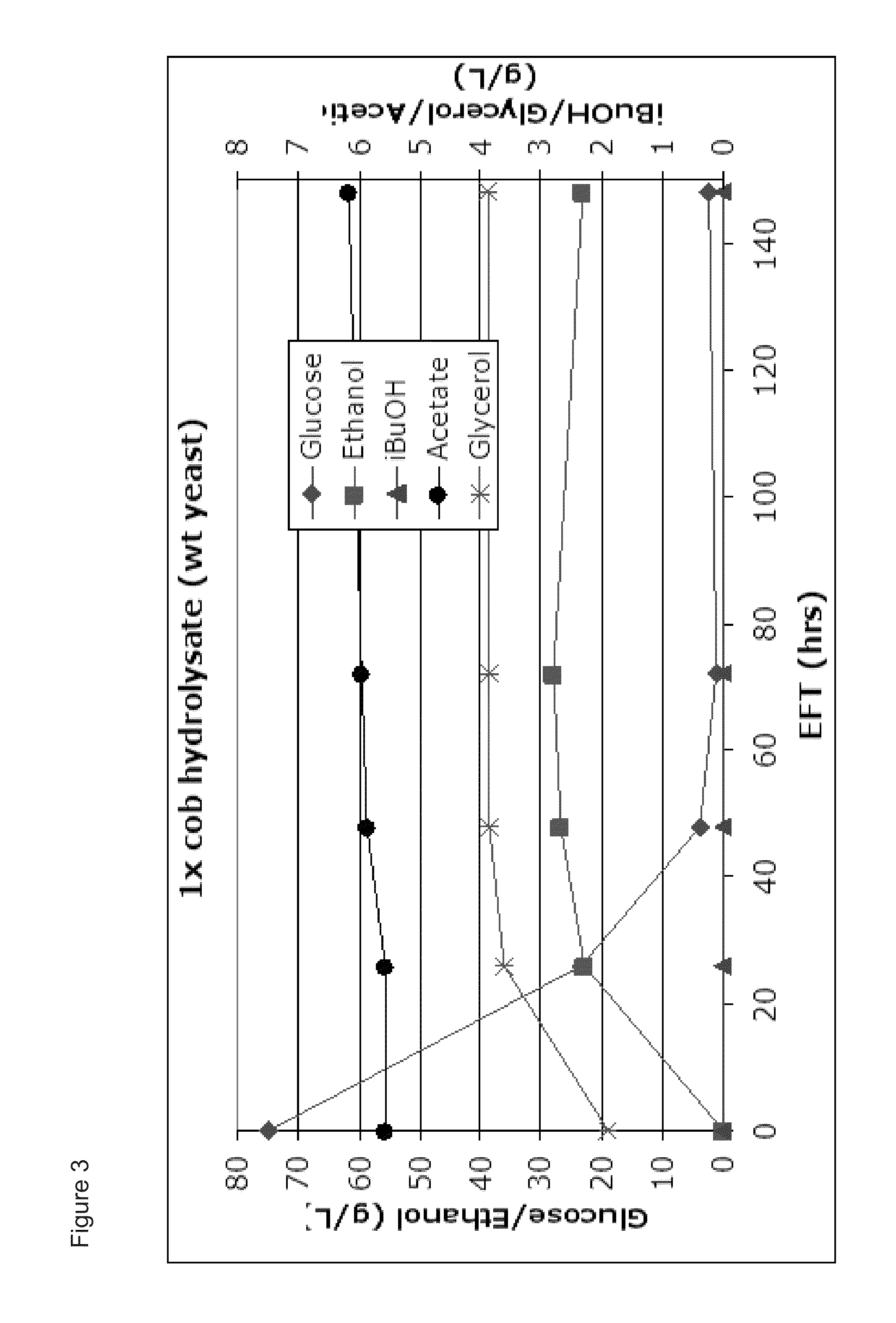Lignocellulosic hydrolysates as feedstocks for isobutanol fermentation
- Summary
- Abstract
- Description
- Claims
- Application Information
AI Technical Summary
Benefits of technology
Problems solved by technology
Method used
Image
Examples
example 1
Conversion of Fermentable Carbons in Lignocellulosic Hydrolysates to Isobutanol Methods
[0164]Lignocellulosic hydrolysate (LCH) was produced from ground corn cob that had been pretreated by a dilute ammonia and heat process then enzymatically hydrolyzed with a mixture of commercial cellulase and hemicellulase enzyme preparations at 25% percent pretreated corn cob solids, pH 5.3 and 48° C. for 96 hours, all as described in U.S. Publication No. 2007 / 0031918A1, which is herein incorporated by reference. The primary sugar and acetate concentrations in the resulting hydrolysate were: 75 g / L glucose; 54 g / L xylose, 6 g / L arabinose, and 5 g / L acetate.
[0165]Two yeast strains were used. The first, CEN.PKI 13-7D, is a wildtype ethanologenic strain. Van Dijken et al., Enzyme Microb Technol 26:706-714 (2000). The second strain, PNY1504 is an isobutanologenic strain. The strain was created from PNY1503 (MATa ura3Δ::loxP his3Δ pdc6Δ pdc1Δ::P[PDC1]-DHADIilvD_Sm-PDClt pdc5Δ::P[PDC5]-ADH|sadB_Ax-PDC5...
example 2
Conversion of C-5 Sugars to C-4 Alcohol in Defined Medium
Methods
[0170]Strain PNY1504 was pre-cultured in the defined medium SC-GE as described above, except that the medium was buffered to pH 6. Production cultures used the same SC medium, except either glucose or xylose was added to a final concentration of 35 g / L, and penicillin G (Sigma P3032) was added at 25 μg / ml.
[0171]Unless it is genetically engineered to do so, S. cerevisiae is unable to ferment xylose, but it is able to ferment xylulose. In order to test whether xylose is available for fermentation to isobutanol, it was converted to xylulose in situ by xylose isomerase (10 g / L; Sigma G4166) essentially as described in Lastick S. M., et al., Applied Microbiology and Biotechnology 30:574-579 (1989), Wang P. Y., et al., Biotechnology Letters 2:273-278 (1980) and Chandrakant P & Bisaria V S, Appl Microbiol Biotechnol 53:301-309 (2000).
[0172]Xylulose can be taken up by yeast and metabolized via the pentose phosphate pathway. It ...
example 3
[0178]The isobutanol produced in the preceding Examples may be recovered by in situ product recovery process in accordance with the methods of U.S. Provisional Application No. 61 / 356,290, filed on Jun. 18, 2010. The in situ product recovery (ISPR) methods described therein provide for improved butanol production by the removal of inhibitors prior to and during fermentation. The utilization of mixed sugars by the recombinant organism with the ISPR techniques may provide for improvements in butanol production through one or more if increased sugar utilization, decreased inhibitor profiles and increased alcohol product tolerance.
PUM
| Property | Measurement | Unit |
|---|---|---|
| Fraction | aaaaa | aaaaa |
| Fraction | aaaaa | aaaaa |
| Mass | aaaaa | aaaaa |
Abstract
Description
Claims
Application Information
 Login to View More
Login to View More - R&D
- Intellectual Property
- Life Sciences
- Materials
- Tech Scout
- Unparalleled Data Quality
- Higher Quality Content
- 60% Fewer Hallucinations
Browse by: Latest US Patents, China's latest patents, Technical Efficacy Thesaurus, Application Domain, Technology Topic, Popular Technical Reports.
© 2025 PatSnap. All rights reserved.Legal|Privacy policy|Modern Slavery Act Transparency Statement|Sitemap|About US| Contact US: help@patsnap.com



